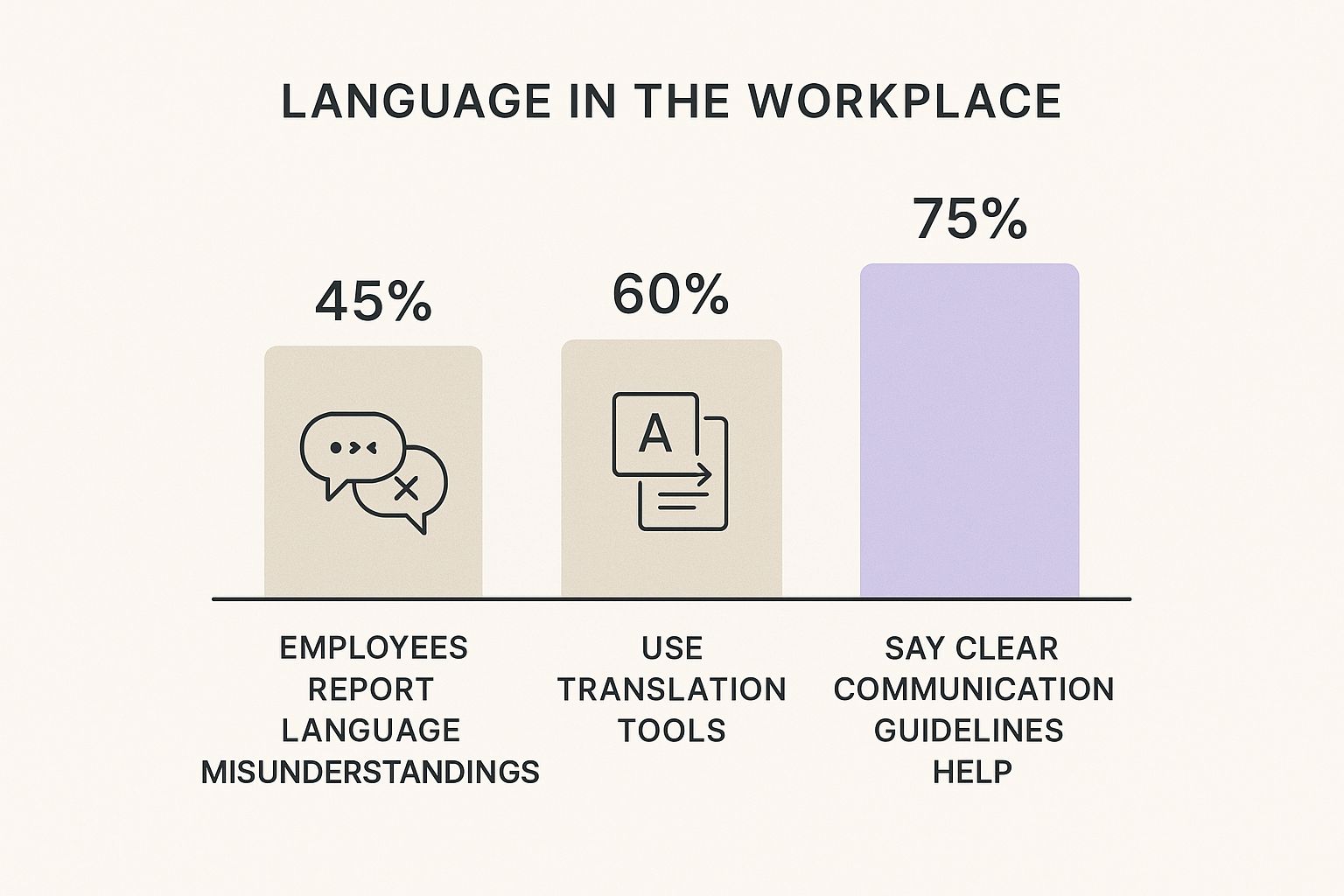
In a world where business is increasingly global, getting cross-cultural communication in the workplace right isn't just a "nice-to-have" soft skill. It's the very foundation of success. This is what transforms a scattered group of talented individuals into a cohesive, high-performing team, making it a non-negotiable for any company with global ambitions.

Picture this: a software project brings together a team from Germany, known for direct and explicit instructions, with a team in Japan, where communication is often high-context and subtle. Without a shared understanding, wires get crossed. The German team might see polite suggestions as a lack of firm commitment, while the Japanese team could perceive direct feedback as blunt or even disrespectful.
This common scenario proves a critical point—talent and tech alone don't build winning teams. The real magic happens when people from different backgrounds truly understand each other's nuances. That's when you unlock powerful synergy.
Cultural fluency goes way beyond just preventing mix-ups; it's a strategic advantage that directly fuels your bottom line. It’s the ability to read between the lines—to understand not just what is said, but how it's said and why it matters within a specific cultural context.
When communication flows effortlessly across cultures, teams make fewer mistakes, deliver projects faster, and become far more creative at solving problems. This isn’t about being polite. It's about being effective.
This boost in collaboration has a real, measurable impact. A Boston Consulting Group study discovered that companies with above-average management diversity—a direct result of inclusive, cross-cultural practices—generated 45% of their revenue from innovation. For companies with less diverse leadership, that number plummeted to just 26%. The data paints a clear picture: healthy cross-cultural dynamics drive financial performance. You can dig into the specifics of this link in the BCG analysis.
To help frame these ideas, we can break down the core components of strong cross-cultural communication.
The table below outlines the key pillars that support effective collaboration in diverse teams, connecting each concept to its direct business impact.
| Pillar | Description | Business Impact |
|---|---|---|
| Awareness | Recognizing that cultural differences exist and influence behavior, without judgment. | Reduces unintentional friction and promotes a more inclusive atmosphere. |
| Respect | Valuing and acknowledging different communication styles, work ethics, and perspectives. | Builds psychological safety, encouraging open dialogue and honest feedback. |
| Adaptability | Modifying one's own communication style to better meet the needs of others. | Increases efficiency by ensuring messages are received and understood as intended. |
| Empathy | The ability to understand and share the feelings of another from their cultural viewpoint. | Strengthens team bonds, improves conflict resolution, and boosts morale. |
By building on these four pillars, organizations don't just avoid missteps; they create a powerful competitive advantage.
The ultimate goal of improving cross cultural communication in the workplace is to build an environment where every single voice is heard, respected, and valued. This takes more than just language translation. It demands a real commitment to understanding different working styles, values, and social norms.
The benefits are immediate and tangible:
Effective communication is the lifeblood of any successful team, but it's especially critical when everyone is geographically dispersed. For more great insights on this, check out these tips for managing remote teams.
Ultimately, investing in these skills is an investment in your company's competitive edge. When you bridge cultural gaps, you’re not just assembling a group of people from around the world—you’re building a truly global team capable of achieving incredible things together.

Even with the best game plan, running a high-performing global team means you’ll eventually hit some communication snags. These barriers aren't just minor annoyances. They’re the silent disruptors that can kill productivity, chip away at trust, and smother the very innovation you hired a diverse team to create. The first step to knocking them down is knowing what they look like.
Picture this: a project manager in Chicago fires off a direct, action-focused email to a developer in Bogotá. The manager thinks they're being efficient. But the developer, who comes from a culture that prioritizes building relationships first, might read the tone as abrupt or even disrespectful. This tiny misunderstanding, born from different cultural norms, can inject just enough friction to slow the entire project down.
This isn't just talk. Recent research on global teams in multinational corporations has pinpointed the key obstacles that consistently trip companies up. The study flags language differences, mismatched communication styles, and non-verbal misreads as the top culprits. You can dive deeper into these findings and their impact on team dynamics by reading the full research on global team challenges.
When your team is remote or distributed, the potential for crossed wires goes way up. We lose all that rich context we get from body language, tone of voice, and just being in the same room. A delayed response on Slack or a moment of silence on a video call can be interpreted in a dozen different ways—and most of them are negative.
Think about these all-too-common scenarios where communication goes sideways:
Effective cross cultural communication in the workplace isn't about trying to erase differences. It's about building a system of mutual understanding where those differences are expected, respected, and navigated with purpose.
To get ahead of these problems, it helps to break them down into categories. Once you understand the root cause, your team can build targeted strategies to overcome them. These roadblocks usually fall into a few key areas that go far beyond just translating words.
What does "urgent" actually mean? To one team member, it might mean drop everything and get it done in the next hour. To another, it could mean finishing the task by the end of the day. Attitudes toward deadlines can be just as different. Some cultures treat deadlines as set in stone, while others see them as flexible guidelines. This kind of disconnect is a recipe for frustration and project delays.
How a culture views authority has a massive impact on communication. In some hierarchical cultures, team members would never dream of openly challenging a manager's idea. In more egalitarian environments, open debate and direct feedback are not just accepted but expected, regardless of job title. When these two styles collide, one group can end up feeling disrespected while the other feels completely unheard.
Time zones are more than just a logistical headache for scheduling meetings. They create communication delays that can breed misunderstanding and a sense of disconnect. A simple question asked at the end of one person’s day might not get answered until the next morning, grinding progress to a halt. Proactive planning is a must, and you can learn more by checking out our guide to overcoming the challenges of time zone differences when hiring from LatAm.
By anticipating these barriers, your team can build a more resilient and effective communication framework from day one.
If you want to instantly upgrade your effectiveness on a global team, there’s one core concept you need to master: the difference between high-context and low-context communication. Think of it as the contrast between a nuanced conversation and a detailed instruction manual. Getting this right is fundamental to improving cross cultural communication in the workplace.
Imagine you’re building a piece of furniture. A low-context culture gives you a manual where every screw is labeled, every step is illustrated, and nothing is left to chance. The message is explicit, direct, and completely self-contained.
On the other hand, a high-context culture gives you a simple sketch. It assumes you understand the unspoken rules of furniture assembly based on shared experience. Here, the meaning isn't just in the words—it's woven into the relationship, the non-verbal cues, and the shared understanding.
In low-context communication, clarity and directness are prized above all else. The responsibility for ensuring a message is understood rests squarely on the sender. They’re expected to be precise, articulate, and thorough. Any vagueness is often seen as inefficient or, even worse, a sign of dishonesty.
This style thrives on literal meaning. When a manager says, “I need this report by 5 PM Friday,” they mean exactly that. There’s no hidden request or underlying tone to decipher. Feedback is typically straightforward, focusing on the task, not the person.
This direct approach is common in countries like the United States, Germany, Australia, and Scandinavia. Team members from these backgrounds expect communication to be logical, linear, and clearly documented.
Understanding this variance is crucial for effective collaboration. North American and Western European cultures tend to favor these direct styles, viewing straightforwardness as a sign of honesty. In contrast, many Asian and Latin American cultures use more indirect approaches. You can discover more insights about global communication styles and see how they impact business interactions firsthand.
In high-context cultures, communication is far more layered. Meaning is often embedded in the context of the situation, the relationship between speakers, and non-verbal signals like body language, tone of voice, and eye contact. What isn't said can be just as important as what is.
For example, a team member from a high-context culture like Japan or Saudi Arabia might express disagreement not by saying "I don't like that idea," but with a phrase like, "That is an interesting perspective; we will need to study it further." This is a polite, relationship-preserving way of signaling reservations without causing a direct confrontation.
In high-context environments, building trust and rapport is the necessary first step before any real business can be done. Communication is about maintaining harmony and strengthening relationships.
Directly challenging an idea or providing blunt feedback can be seen as disruptive and disrespectful. It can damage the relationship and jeopardize the entire project. This is why "reading the air"—or sensing the unspoken group sentiment—is such a vital skill.
The infographic below shows how these communication challenges are being met with practical solutions like clearer guidelines and better technology.

The data is telling. While 45% of employees report misunderstandings due to cultural differences, a massive 75% agree that clear communication guidelines are a powerful solution.
To help you navigate these differences, the table below breaks down the key characteristics of each style.
| Characteristic | Low-Context (e.g., USA, Germany) | High-Context (e.g., Japan, Saudi Arabia) |
|---|---|---|
| Message Focus | Explicit, direct, and verbal. Facts and data are key. | Implicit, indirect, and contextual. Relationships and non-verbals matter. |
| Pace of Business | Fast and efficient. Get to the point quickly. | Slower, with time invested in building relationships first. |
| Agreements | Rely on written contracts and detailed documentation. | Rely on verbal agreements and trust. A person's word is their bond. |
| Feedback Style | Direct, constructive, and focused on the task. | Indirect, diplomatic, and focused on preserving harmony. |
| Example Phrase | "I disagree with this approach for three reasons…" | "That's an interesting idea. Let's explore other possibilities as well." |
Understanding these distinctions is the first step. The next is learning to adapt.
The key to success isn't deciding which style is "better"—it's learning to recognize which one is at play and adjusting your own approach. This flexibility is what separates functional global teams from truly high-performing ones.
Here are a few practical tips for bridging the gap:
By mastering the ability to decode and adapt to these communication styles, you'll build trust, prevent costly misunderstandings, and unlock the full potential of your diverse global team.

Knowing the theory behind communication styles is one thing. Putting it into practice is where the real magic happens. This is how you move from theory to action and turn a collection of individuals into a tight-knit, effective team. Let's dive into a practical toolkit to help you foster better cross cultural communication in the workplace, starting now.
These aren't just high-level ideas; they're strategies you can start using in your very next meeting, feedback session, or daily stand-up. The goal is simple: build a more respectful and inclusive environment where everyone feels seen, heard, and ready to do their best work.
Meetings are a pressure cooker for cultural communication differences. If you don't set the stage correctly, they can easily get hijacked by the loudest voices, leaving others feeling sidelined. A little proactive planning can make all the difference.
Here are a few simple steps to make your meetings more equitable:
Implementing these small tweaks creates a more predictable and psychologically safe space for everyone, no matter their cultural background or communication style.
Active listening isn’t just about keeping quiet while someone else talks. It's about truly understanding the intent, emotion, and context behind their words. In a cross-cultural team, this skill is your superpower for building trust and sidestepping misunderstandings.
Active listening means you stop focusing on what you're going to say next and start focusing entirely on what the other person is trying to convey. It requires patience, empathy, and a genuine desire to understand another's perspective.
For instance, if a colleague from a high-context culture says, "We will need to look into that further," don't just nod and move on. An active listener might probe gently with an open-ended question like, "That's a good point. What specific concerns or potential challenges do you foresee with this approach?" This invites them to share more without putting them on the spot.
To truly excel, it’s vital to develop essential cross cultural communication skills that pave the way for genuine understanding and teamwork. This foundation makes every single interaction more powerful.
Giving feedback across cultural lines is probably one of the trickiest parts of managing a global team. What one person considers direct and helpful, another might find blunt and offensive. The secret is to tailor your approach to the individual and their cultural norms.
Giving Feedback to an Indirect Communicator:
Giving Feedback to a Direct Communicator:
Learning to navigate these nuances is a core part of leading a successful global team. If you want to go deeper on this, check out our guide on how to manage remote teams across different cultures. By applying these strategies with care, you'll build a stronger, more unified team that runs on mutual respect.
In a digital-first workplace, technology can be a powerful force for unity or a frustrating source of division. The difference comes down to how intentionally we use it. When managed thoughtfully, the right digital tools become bridges that help close cultural divides and create a more level playing field for every team member. This is a huge piece of the puzzle for effective cross cultural communication in the workplace.
Instead of seeing technology as just a stack of productivity tools, we need to reframe it as a platform for equity. It's about consciously choosing and using platforms that foster clarity, set solid expectations, and give everyone an equal shot to contribute their best work—no matter their time zone or native language.
One of the biggest hurdles for any global team is just making sure everyone is on the same page. When conversations or meeting outcomes are left open to interpretation, you’re basically inviting confusion and mistakes. Shared documents and project management tools are the perfect antidote.
Platforms like Google Docs, Notion, or Asana can serve as a single source of truth. By getting everything down in writing—from meeting notes and action items to project goals and processes—you stamp out ambiguity. This is especially helpful for team members from high-context cultures who might not feel comfortable asking for clarification in a group setting.
This screenshot from LatHire's homepage reflects a deep commitment to connecting talent across borders—a process that leans heavily on clear, technology-driven communication.
Platforms like this are built on the idea that with the right tools, geographical and cultural boundaries become less of a barrier to great work.
Video conferencing is the new office, but it comes with its own quirks. To make these digital spaces more inclusive, leaders have to set clear ground rules that account for cultural differences.
Technology doesn't automatically create clarity; it simply amplifies the communication habits you already have. Using it well requires a deliberate strategy focused on inclusion and psychological safety.
For example, encourage everyone to use the "raise hand" feature. It’s a simple way to make sure everyone gets a turn to speak, preventing more assertive personalities from dominating the discussion. It's also smart to normalize using the chat for questions. This gives people who are less comfortable interrupting a direct line to participate. To see how this plays out in the real world, check out how technology drives remote work success in Latin America, where clear digital communication is absolutely critical.
Finally, while they're not perfect, modern translation tools can be a game-changer for breaking down language barriers in writing. Integrated features in email clients or platforms like Slack help ensure the core message gets across, even if some of the finer nuances are lost. Just remember to encourage your team to use simple, direct language and steer clear of idioms—it makes these tools work much better. When you use technology with purpose, you don’t just get more work done; you build a more connected and efficient global team.
Of course. Here is the rewritten section, designed to sound completely human-written and natural, following all the provided requirements.
Alright, let's move from theory to reality. It's one thing to talk about the principles of cross cultural communication in the workplace, but it's another thing entirely to make them work on the ground. This is where the real progress happens.
So, think of this section as your practical playbook. We’re going to tackle the most common, real-world questions and challenges that pop up when you're trying to build a truly connected global team. These are the sticking points that can either stall progress or, if handled right, become your team's greatest strengths.
This is a classic—and critical—challenge. It comes up all the time, especially when you have a mix of high-context and low-context communicators in one virtual room. The biggest mistake is to put someone on the spot. The key isn't forcing spontaneous comments, but creating structured, low-pressure opportunities for everyone to contribute.
A little proactivity goes a long way. Start by sending out a detailed meeting agenda at least 24 hours ahead of time, complete with the specific questions you'll be discussing. This simple step is a game-changer. It gives everyone, particularly those from more reflective cultures, the space to gather their thoughts without the pressure of a ticking clock. It levels the playing field before you even hit "join."
Then, in the meeting itself, ditch the free-for-all format that always seems to favor the loudest voices.
Do this consistently, and you'll build psychological safety. It sends a powerful message: we value your ideas, no matter how you choose to share them. Over time, you'll see even the most reserved team members start to open up.
If you're looking for the single most impactful first move, it's this: build shared awareness. Before you roll out new tools or rules, everyone needs to get on the same page. You have to make the implicit, explicit.
Set aside time for a dedicated, non-judgmental team conversation about communication itself. This isn't a performance review or a session to point fingers. It's a collective discovery process. Your goal is to create a space where people feel safe sharing their cultural backgrounds and what effective communication looks like to them. The whole point is to establish a foundational understanding that "different" doesn't mean "wrong."
The most powerful starting point is a collective agreement, not a top-down mandate. By co-creating communication norms, the team gains a sense of ownership over the process, making adoption far more likely.
The output of this discussion should be a "Team Communication Charter." This is your team's living, breathing rulebook, created by and for the team.
This charter could include simple, powerful agreements like:
Starting here—with shared awareness and a co-created charter—is infinitely more powerful than just dropping a new policy into everyone's inbox.
Yes, but with a huge asterisk. Their effectiveness hinges entirely on how they're designed and delivered. A one-off, generic lecture on cultural theory is a waste of everyone's time. It might tick a compliance box, but it won't change a single behavior.
For training to actually work, it needs to be ongoing, interactive, and directly tied to your team’s daily work. The best programs get out of the textbook and into practical application. Think role-playing real scenarios your team faces, like giving feedback across cultures or navigating a project disagreement when styles clash.
The programs that truly move the needle also include:
When it's done thoughtfully, formal training can absolutely be a catalyst for improving cross cultural communication in the workplace.
This is where things can get heated. When a direct, to-the-point communicator runs up against someone who is more indirect and high-context, sparks can fly. The trick is to de-personalize the conflict immediately and steer the focus back to the business problem at hand.
Someone—a manager or a neutral team member—needs to step in and mediate. The first move is to simply acknowledge that different communication styles are in play. Naming it without placing blame instantly lowers the emotional temperature.
From there, guide the conversation toward understanding, not winning.
The ultimate aim is to create enough space for both people to explain their intent and perspective. You're separating the communication style from the person and the problem. The final, crucial step is to land on a clear, mutually-agreed-upon path forward, making sure both people feel heard and are genuinely aligned on the next steps.
